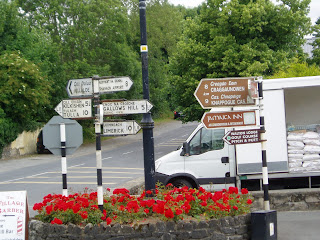






Day 15
After another sumptuous breakfast we headed for Galway where we stopped to take in the sights during our brief walking tour of the old city. However, it was to the Burren National Park where our interest for the day was focused. On any ambitious visit to a foreign country there comes a time when the traveler realizes that not every destination on the itinerary can be visited and some places have to be scratched off the list. Galway was one such casualty. Regretfully, we spent no more than two hours there but had a nice stroll through old town, replete with artists, shops and musicians. Carol lingered over a huge rock and roll tribute mural, and also had a spontaneous dance to a street singer's swanky rendition of “King of the Road”.
Exiting Galway, our next stop was Castle Dunguaire, picturesquely seated at the head of a prominent tidal inlet. We walked around the premises satisfying our curiosity without paying the admission price. Sitting on a stone bench beneath the towering walls we sat for some time watching the birds caper in the marsh below us. Sometimes the best things in life are truly free. The castle's main claim to fame are the nightly medieval banquets. At $120 per couple, I didn't think our two abstemious palettes would recover anything near the investment cost so we elected to move on, preferring the natural wonders of The Burren over the recreated and likely false portrayals of a medieval dining experience.
Arriving at The Burren, a lunar-like landscape, our first stop was at the famous Poulnabrone Dolmen. Constructed around 3500 B.C. it is still an architectural wonder. Viewed from any angle, the structure leaves most modern visitors shaking their heads. How did ancient, stone age builders ever manage to move such large and heavy stones? It seems like an awfully large bother to expend that much time and energy constructing a permanent resting place, in a thoroughly inhospitable environment, for so relatively few people. It's a mystery all right, one that I can't quite fathom.
The Burren is a landscape all its own, with an inviting array of flat stones and wildflowers spreading for miles. We wished we could have spent all day walking it, but instead we pressed on. After leaving The Burren we drove toward the town of Ennis. Along the way we saw signs for the County Clare Genealogy Center, the very place I wanted to visit before going to Sixmilebridge, where my grandfather was born. Unfortunately, by the time we located the building it was closed, meaning I'd have to return the following day to make my inquiries. Since I knew so little about grandpa Mike, I hoped the folks at this heritage center might provide me with additional information that would make my visit to Sixmilebridge more productive.
The last time I was in Ireland was in August of 1969. I was with my parents and my brother Tom. Mike, my other brother, named after my grandfather, was in the Marine Corp at the time, in Vietnam, and still alive. I don't recall too much from that visit to Sixmilebridge other than my father mentioning he wasn't even sure if the small village was the one where his father had been born, despite the fact that the surname, McInerney, was prominently displayed as proprietors of several businesses. I also wasn't sure how determined my father had been to learn more. It seemed at the time he was more interested in golf and drinking in the pub than detective work. On this present visit, I hoped to change that. With the advent of computerized records, I might learn some interesting information and possibly some startling new revelations. I thought to myself, if I don't pursue this, the link might soon be lost forever. My daughter has no interest in any genealogical information, particularly from my side of the family.






































